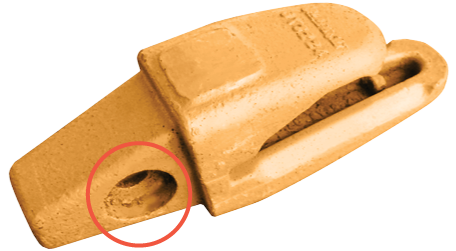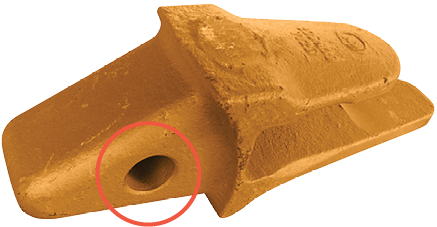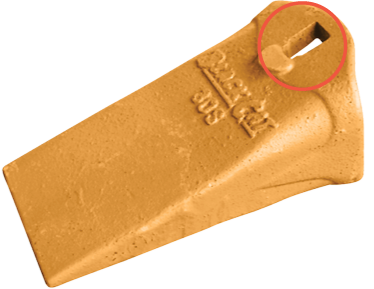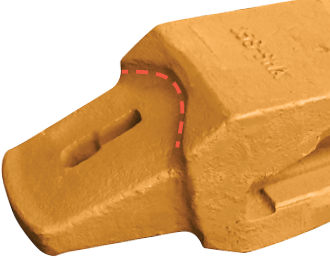
Tooth ID Guide
Bucket Teeth
Identify Your Bucket Tooth
Unsure what bucket teeth you’ve got on your digger? Use this handy guide to find out.
There are several ways to determine your bucket tooth fitment style and size. We only stock bucket teeth for 3-ton diggers and larger. Before we start, there is one obvious place to look for a part number.
The part number of a bucket tooth is typically cast into the interior wall or rear edge of the tooth pocket. If you can’t locate it or make it out, then follow our guide below.
1. Side pin or top pin
Side Pin
There are many side pin bucket tooth fitment styles. By far the most popular is the Cat J-Series. We also stock Komatsu bucket teeth.
Here’s how to tell which is which.
CAT J-SERIES
Cat J-Series pins run horizontally through the tooth and adapter.
J-series has a pin and separate retainer. The pins have a recessed groove at one end to seat the retainer that is inserted into the adapter.
J-Series adapters have a recessed area on one side of the nose that retainer is inserted into.
KOMATSU
Komatsu bucket teeth have an integrated centre-ring pin and retainer that looks like this:
Komatsu adapters can be distinguished from Cat J-Series because they have no recessed area for a retainer on the nose.
Top Pin
ESCO CONICAL
ESCO Conical bucket teeth have a vertical pin system. The hole is on the top and is rectangular shape with a square top and rounded bottom.
The pins and rubber retainers look like this:
The top end of the tooth tends to have a rounded shape that fits into a concave counterspace on the adapter.
2. Machine size
Once you have identified the fitment style the next step is to confirm the fitment size. The quickest way to narrow down where to look is to use the machine size. The correct size adapters should be fitted to a bucket that is designed for a specific machine size. Correct advice isn’t always followed but it is a good start to help identify your fitment size. The first page in every bucket tooth section in this catalogue features a handy chart that matches the correct machine tonnage with fitment sizes.
3. Pin & retainer size
Measuring your pins and retainers is the most accurate way to determine your fitment size because they are manufactured to more exacting measurements than cast teeth. Now that you know what fitment type and size matches your machine tonnage, you can find the product listings for the pin and retainer in that size. Check the table of measurements that reference a diagram of your pin/retainer. Closely match those listed to confirm your fitment size. If the measurements differ then check the measurements of pin/retainers for the fitment
4. Tooth pocket size
If you’re still unsure, or you want to double-check your result, you can measure the interior pocket opening of your worn/ other teeth. The pocket is the area that the adapter nose fits into. The interior pocket is subject to minimal wear during the life of a bucket tooth. This makes it a good location to compare measurements.
5. Success!
If you’re not confident that you’ve identified the correct part get in touch and we can help.
DISCLAIMER: Real Steel is not responsible for customers who use this guide and order the wrong teeth. We offer a 90-day returns policy on incorrect purchases.
Like what you see and want to learn more?









